Abstract
We report the characterization of a mutant of Azorhizobium caulinodans, isolated after ethyl methanesulfonate mutagenesis. This Nod+ Nif- Fix- mutant is unable to synthesize 10 of 15 polypeptides normally induced under conditions of nitrogen fixation. By using lacZ fusions it was shown that nifA and nifA-regulated genes were not expressed in this strain. The mutation was complemented by a constitutively expressed nifA gene or by a 1.1-kb DNA fragment from the wild-type strain, whose nucleotide sequence revealed a single open reading frame of 255 bp coding for an 85-amino acid polypeptide. The deduced amino acid sequence is similar to that of HF-I, an RNA-binding protein of Escherichia coli, which is required for replication of bacteriophage Q beta RNA. The similarity can be extended to the function since hfq, the structural gene for HF-I, complemented the A. caulinodans mutant. The corresponding gene in A. caulinodans was termed nrfA (for nif regulatory factor). Inactivation of nrfA in the mutant was due to a missense mutation resulting in the replacement of a cysteine residue by arginine. A null mutant, constructed by disruption of nrfA, exhibited the same phenotype as the missense mutant. Thus, an additional factor can be added to the already complex system of nifA regulation in A. caulinodans.
Full text
PDF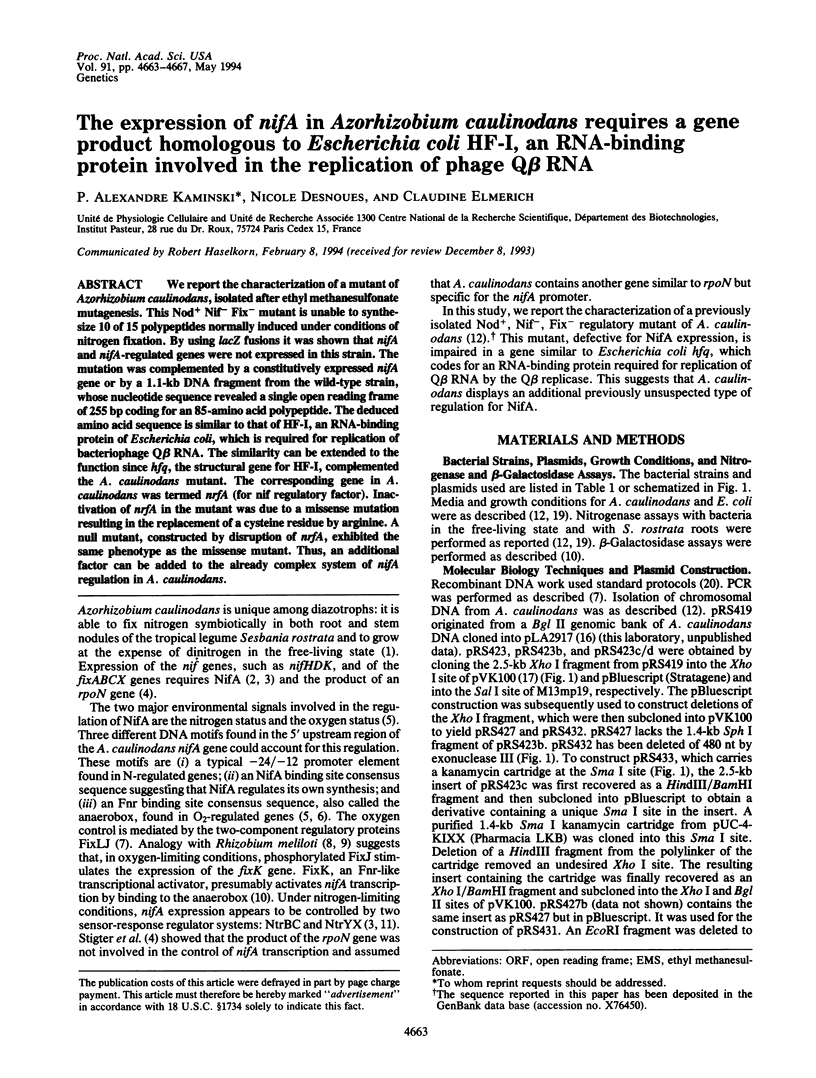
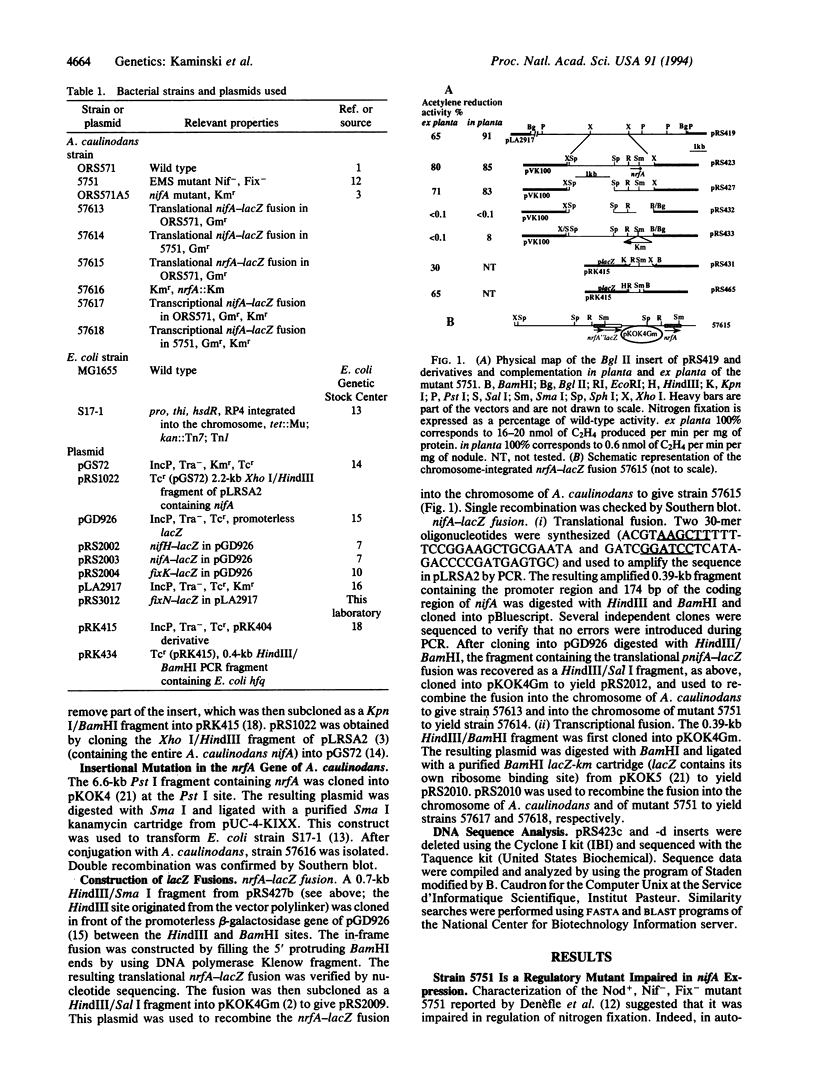
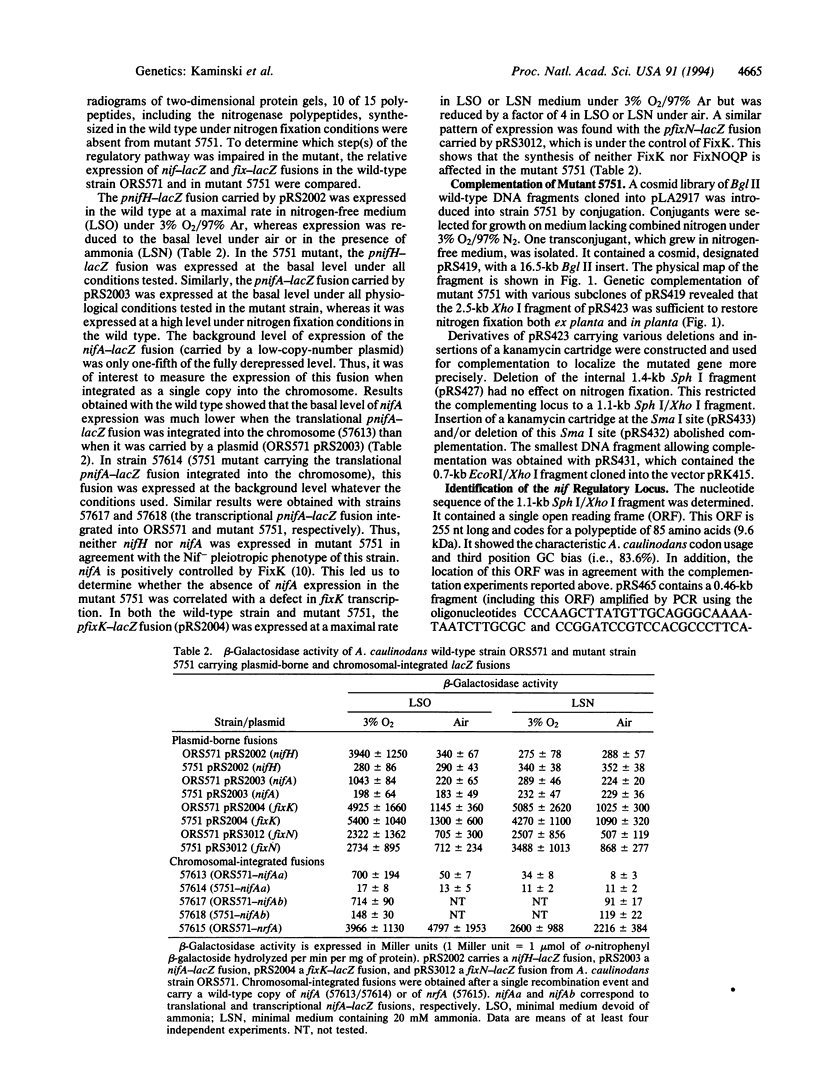
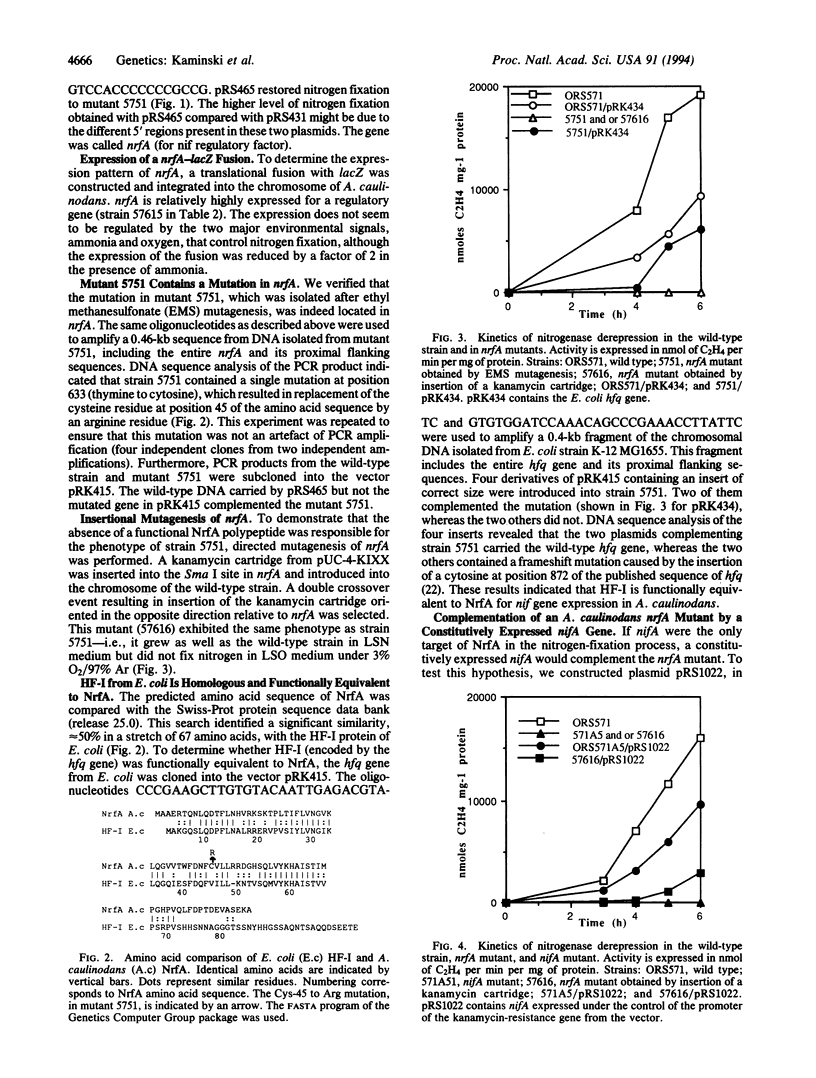
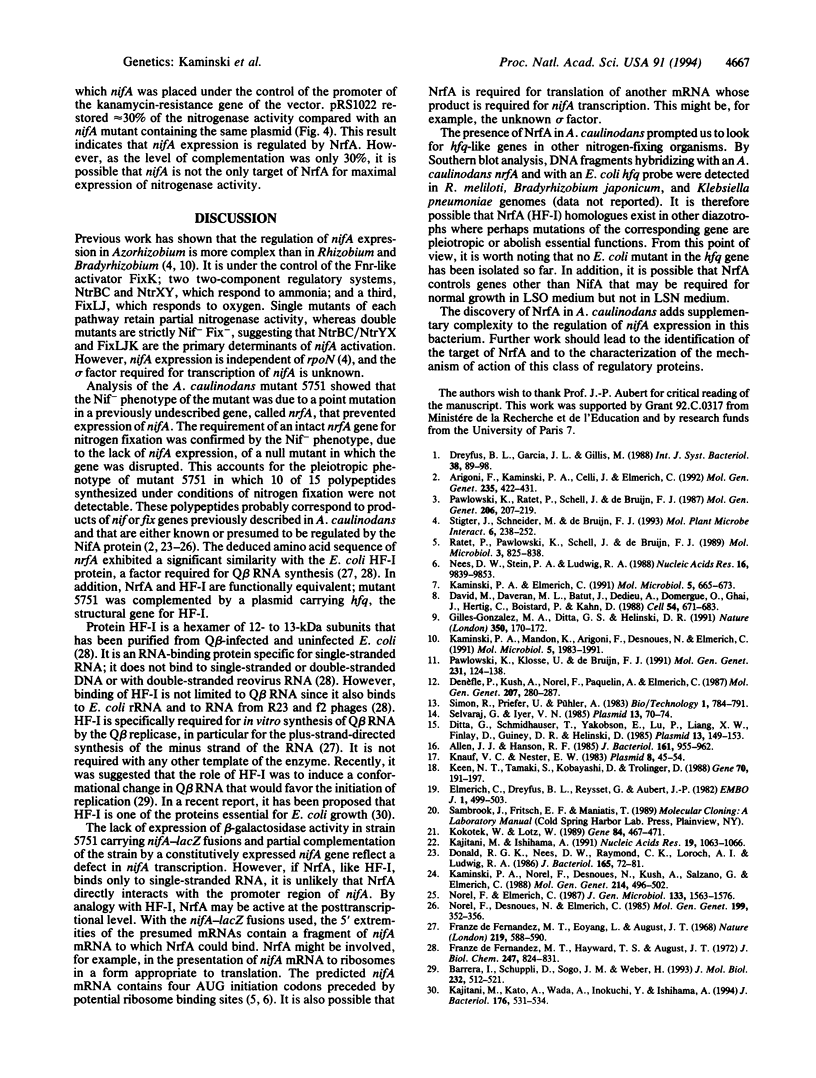
Selected References
These references are in PubMed. This may not be the complete list of references from this article.
- Allen L. N., Hanson R. S. Construction of broad-host-range cosmid cloning vectors: identification of genes necessary for growth of Methylobacterium organophilum on methanol. J Bacteriol. 1985 Mar;161(3):955–962. doi: 10.1128/jb.161.3.955-962.1985. [DOI] [PMC free article] [PubMed] [Google Scholar]
- Arigoni F., Kaminski P. A., Celli J., Elmerich C. Transcriptional analysis of the fix ABCXORF1 region of Azorhizobium caulinodans suggests post-transcriptional processing of the fix ABCXORF1 mRNA. Mol Gen Genet. 1992 Nov;235(2-3):422–431. doi: 10.1007/BF00279389. [DOI] [PubMed] [Google Scholar]
- Barrera I., Schuppli D., Sogo J. M., Weber H. Different mechanisms of recognition of bacteriophage Q beta plus and minus strand RNAs by Q beta replicase. J Mol Biol. 1993 Jul 20;232(2):512–521. doi: 10.1006/jmbi.1993.1407. [DOI] [PubMed] [Google Scholar]
- David M., Daveran M. L., Batut J., Dedieu A., Domergue O., Ghai J., Hertig C., Boistard P., Kahn D. Cascade regulation of nif gene expression in Rhizobium meliloti. Cell. 1988 Aug 26;54(5):671–683. doi: 10.1016/s0092-8674(88)80012-6. [DOI] [PubMed] [Google Scholar]
- Ditta G., Schmidhauser T., Yakobson E., Lu P., Liang X. W., Finlay D. R., Guiney D., Helinski D. R. Plasmids related to the broad host range vector, pRK290, useful for gene cloning and for monitoring gene expression. Plasmid. 1985 Mar;13(2):149–153. doi: 10.1016/0147-619x(85)90068-x. [DOI] [PubMed] [Google Scholar]
- Donald R. G., Nees D. W., Raymond C. K., Loroch A. I., Ludwig R. A. Characterization of three genomic loci encoding Rhizobium sp. strain ORS571 N2 fixation genes. J Bacteriol. 1986 Jan;165(1):72–81. doi: 10.1128/jb.165.1.72-81.1986. [DOI] [PMC free article] [PubMed] [Google Scholar]
- Elmerich C., Dreyfus B. L., Reysset G., Aubert J. P. Genetic analysis of nitrogen fixation in a tropical fast-growing Rhizobium. EMBO J. 1982;1(4):499–503. doi: 10.1002/j.1460-2075.1982.tb01197.x. [DOI] [PMC free article] [PubMed] [Google Scholar]
- Franze de Fernandez M. T., Eoyang L., August J. T. Factor fraction required for the synthesis of bacteriophage Qbeta-RNA. Nature. 1968 Aug 10;219(5154):588–590. doi: 10.1038/219588a0. [DOI] [PubMed] [Google Scholar]
- Franze de Fernandez M. T., Hayward W. S., August J. T. Bacterial proteins required for replication of phage Q ribonucleic acid. Pruification and properties of host factor I, a ribonucleic acid-binding protein. J Biol Chem. 1972 Feb 10;247(3):824–831. [PubMed] [Google Scholar]
- Gilles-Gonzalez M. A., Ditta G. S., Helinski D. R. A haemoprotein with kinase activity encoded by the oxygen sensor of Rhizobium meliloti. Nature. 1991 Mar 14;350(6314):170–172. doi: 10.1038/350170a0. [DOI] [PubMed] [Google Scholar]
- Kajitani M., Ishihama A. Identification and sequence determination of the host factor gene for bacteriophage Q beta. Nucleic Acids Res. 1991 Mar 11;19(5):1063–1066. doi: 10.1093/nar/19.5.1063. [DOI] [PMC free article] [PubMed] [Google Scholar]
- Kajitani M., Kato A., Wada A., Inokuchi Y., Ishihama A. Regulation of the Escherichia coli hfq gene encoding the host factor for phage Q beta. J Bacteriol. 1994 Jan;176(2):531–534. doi: 10.1128/jb.176.2.531-534.1994. [DOI] [PMC free article] [PubMed] [Google Scholar]
- Kaminski P. A., Elmerich C. Involvement of fixLJ in the regulation of nitrogen fixation in Azorhizobium caulinodans. Mol Microbiol. 1991 Mar;5(3):665–673. doi: 10.1111/j.1365-2958.1991.tb00738.x. [DOI] [PubMed] [Google Scholar]
- Kaminski P. A., Mandon K., Arigoni F., Desnoues N., Elmerich C. Regulation of nitrogen fixation in Azorhizobium caulinodans: identification of a fixK-like gene, a positive regulator of nifA. Mol Microbiol. 1991 Aug;5(8):1983–1991. doi: 10.1111/j.1365-2958.1991.tb00820.x. [DOI] [PubMed] [Google Scholar]
- Kaminski P. A., Norel F., Desnoues N., Kush A., Salzano G., Elmerich C. Characterization of the fixABC region of Azorhizobium caulinodans ORS571 and identification of a new nitrogen fixation gene. Mol Gen Genet. 1988 Nov;214(3):496–502. doi: 10.1007/BF00330486. [DOI] [PubMed] [Google Scholar]
- Keen N. T., Tamaki S., Kobayashi D., Trollinger D. Improved broad-host-range plasmids for DNA cloning in gram-negative bacteria. Gene. 1988 Oct 15;70(1):191–197. doi: 10.1016/0378-1119(88)90117-5. [DOI] [PubMed] [Google Scholar]
- Knauf V. C., Nester E. W. Wide host range cloning vectors: a cosmid clone bank of an Agrobacterium Ti plasmid. Plasmid. 1982 Jul;8(1):45–54. doi: 10.1016/0147-619x(82)90040-3. [DOI] [PubMed] [Google Scholar]
- Kokotek W., Lotz W. Construction of a lacZ-kanamycin-resistance cassette, useful for site-directed mutagenesis and as a promoter probe. Gene. 1989 Dec 14;84(2):467–471. doi: 10.1016/0378-1119(89)90522-2. [DOI] [PubMed] [Google Scholar]
- Nees D. W., Stein P. A., Ludwig R. A. The Azorhizobium caulinodans nifA gene: identification of upstream-activating sequences including a new element, the 'anaerobox'. Nucleic Acids Res. 1988 Oct 25;16(20):9839–9853. doi: 10.1093/nar/16.20.9839. [DOI] [PMC free article] [PubMed] [Google Scholar]
- Pawlowski K., Klosse U., de Bruijn F. J. Characterization of a novel Azorhizobium caulinodans ORS571 two-component regulatory system, NtrY/NtrX, involved in nitrogen fixation and metabolism. Mol Gen Genet. 1991 Dec;231(1):124–138. doi: 10.1007/BF00293830. [DOI] [PubMed] [Google Scholar]
- Ratet P., Pawlowski K., Schell J., de Bruijn F. J. The Azorhizobium caulinodans nitrogen-fixation regulatory gene, nifA, is controlled by the cellular nitrogen and oxygen status. Mol Microbiol. 1989 Jun;3(6):825–838. doi: 10.1111/j.1365-2958.1989.tb00231.x. [DOI] [PubMed] [Google Scholar]
- Selvaraj G., Iyer V. N. A small mobilizable IncP group plasmid vector packageable into bacteriophage lambda capsids in vitro. Plasmid. 1985 Jan;13(1):70–74. doi: 10.1016/0147-619x(85)90057-5. [DOI] [PubMed] [Google Scholar]
- Stigter J., Schneider M., de Bruijn F. J. Azorhizobium caulinodans nitrogen fixation (nif/fix) gene regulation: mutagenesis of the nifA -24/-12 promoter element, characterization of a ntrA(rpoN) gene, and derivation of a model. Mol Plant Microbe Interact. 1993 Mar-Apr;6(2):238–252. doi: 10.1094/mpmi-6-238. [DOI] [PubMed] [Google Scholar]


